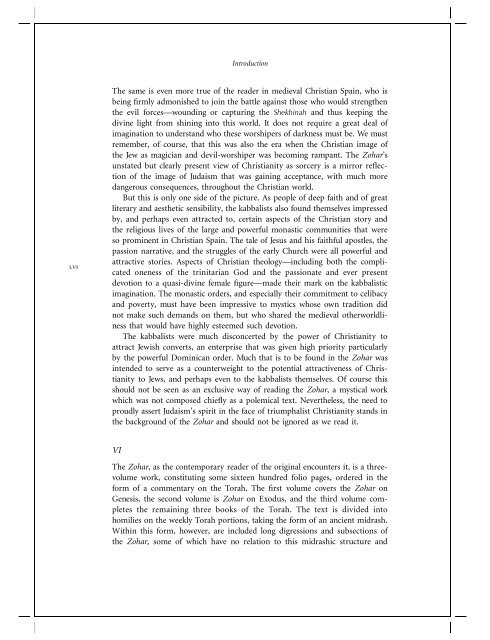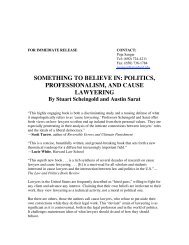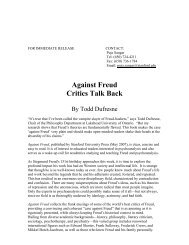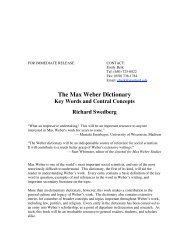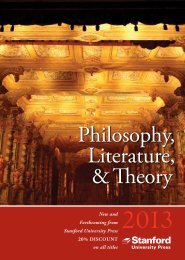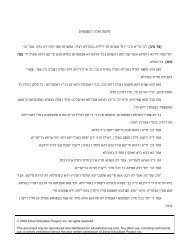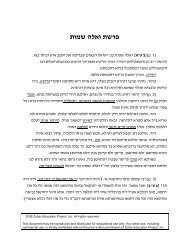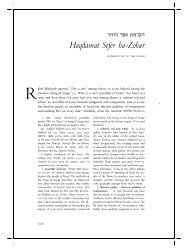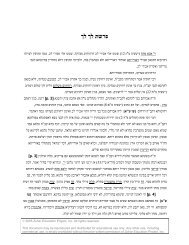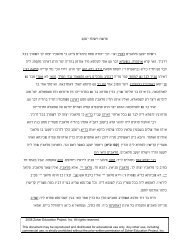Front Matter (PDF) - Stanford University Press
Front Matter (PDF) - Stanford University Press
Front Matter (PDF) - Stanford University Press
Create successful ePaper yourself
Turn your PDF publications into a flip-book with our unique Google optimized e-Paper software.
same is even more true of the reader in medieval Christian Spain, who is<br />
The<br />
admonished to join the battle against those who would strengthen<br />
being®rmly<br />
evil forcesÐwoundingor capturingthe Shekhinah and thus keepingthe<br />
the<br />
light from shining into this world. It does not require a great deal of<br />
divine<br />
to understand who these worshipers of darkness must be. We must<br />
imagination<br />
of course, that this was also the era when the Christian image of<br />
remember,<br />
Jew as magician and devil-worshiper was becoming rampant. The Zohar's<br />
the<br />
but clearly present view of Christianity as sorcery is a mirror re¯ec-<br />
unstated<br />
of the image of Judaism that was gaining acceptance, with much more<br />
tion<br />
consequences, throughout the Christian world.<br />
dangerous<br />
this is only one side of the picture. As people of deep faith and of great<br />
But<br />
and aesthetic sensibility, the kabbalists also found themselves impressed<br />
literary<br />
and perhaps even attracted to, certain aspects of the Christian story and<br />
by,<br />
religious lives of the large and powerful monastic communities that were<br />
the<br />
prominent in Christian Spain. The tale of Jesus and his faithful apostles, the<br />
so<br />
narrative, and the struggles of the early Church were all powerful and<br />
passion<br />
stories. Aspects of Christian theologyÐincluding both the complicated<br />
attractive<br />
oneness of the trinitarian God and the passionate and ever present<br />
to a quasi-divine female ®gureÐmade their mark on the kabbalistic<br />
devotion<br />
The monastic orders, and especially their commitment to celibacy<br />
imagination.<br />
poverty, must have been impressive to mystics whose own tradition did<br />
and<br />
make such demands on them, but who shared the medieval otherworldli-<br />
not<br />
that would have highly esteemed such devotion.<br />
ness<br />
kabbalists were much disconcerted by the power of Christianity to<br />
The<br />
Jewish converts, an enterprise that was given high priority particularly<br />
attract<br />
the powerful Dominican order. Much that is to be found in the Zohar was<br />
by<br />
to serve as a counterweight to the potential attractiveness of Christianity<br />
intended<br />
to Jews, and perhaps even to the kabbalists themselves. Of course this<br />
not be seen as an exclusive way of readingthe Zohar, a mystical work<br />
should<br />
was not composed chie¯y as a polemical text. Nevertheless, the need to<br />
which<br />
assert Judaism's spirit in the face of triumphalist Christianity stands in<br />
proudly<br />
background of the Zohar and should not be ignored as we read it.<br />
the<br />
Zohar, as the contemporary reader of the original encounters it, is a threevolume<br />
The<br />
work, constitutingsome sixteen hundred folio pages, ordered in the<br />
of a commentary on the Torah. The ®rst volume covers the Zohar on<br />
form<br />
the second volume is Zohar on Exodus, and the third volume com-<br />
Genesis,<br />
the remainingthree books of the Torah. The text is divided into<br />
pletes<br />
on the weekly Torah portions, takingthe form of an ancient midrash.<br />
homilies<br />
this form, however, are included longdigressions and subsections of<br />
Within<br />
Zohar, some of which have no relation to this midrashic structure and<br />
the<br />
Introduction<br />
lvi<br />
VI


